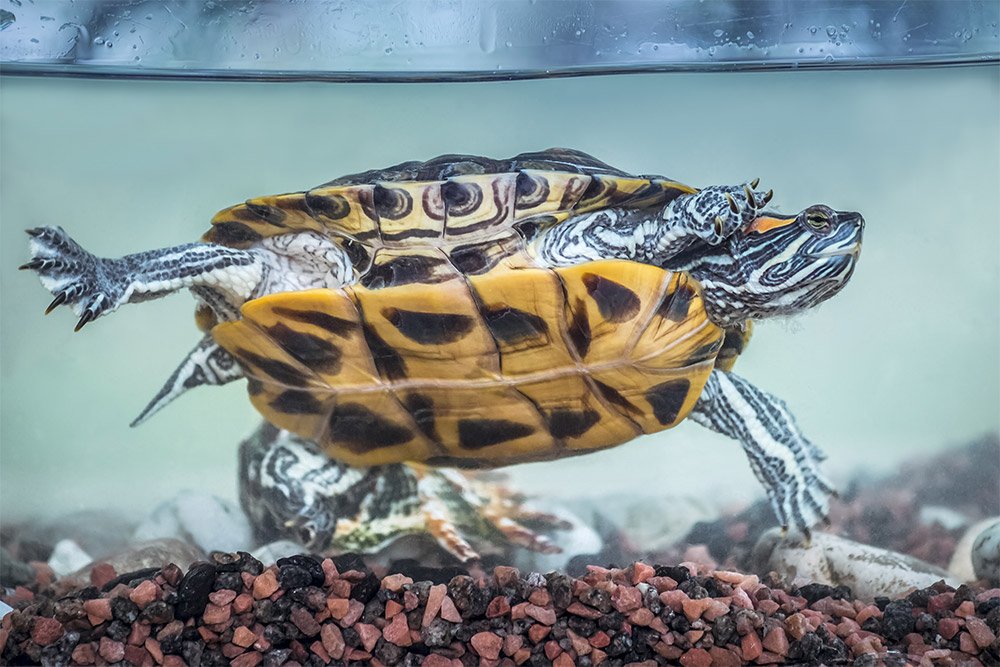Turtles
Mississippi Map Turtles
Scientific Name: Graptemys pseudogeographica kohnii
Native to: Rivers in Mississippi and Missouri
Maximum Length: Males up to 5 inches Females 6-10 inches
Life Span: 20 years+
Characteristics
Mississippi Map turtles are named from the lines and markings on their carapace which resemble the contour lines of a map. These turtles are found in the Mississippi Valley from Illinois and Nebraska, down into the Gulf States from Mississippi to Texas, usually in rivers, lakes and large streams.
Care tips
Enclosure
A minimum 40-gallon tank is needed for a single adult male, but a 10-inch female will need at least a 75-gallon enclosure to ensure adequate space.
Substrate
Bare bottom or river stones large enough that cannot be ingested.
Habitat
Mississippi Map Turtles are very communal and are found in Freshwater lakes, rivers, and
ponds of the Gulf States with dense vegetation. Make sure to provide plenty of space for your turtle,
including a basking area where they can get completely out of the water and a swimming area with
water deep enough to swim. Map turtles are excellent swimmers and will do better in deeper waters.
Even as juveniles they prefer (relatively) deeper water with plenty of cover for security. They tend to
prefer habitat with abundant vegetation. Water should be kept clean and filtered.
Temperature and Lighting
Provide UVB lighting, a basking area of 85 degrees and water temperature of
75 degrees are recommended for these turtles. The basking platform must allow the turtle enough room
to stretch out and fully dry their shell and plastron to avoid shell rot.
Food and Water
Mississippi Map turtles are omnivores. Their diet should consist of a mix of pelleted
turtle food, crickets, mealworms, and leafy greens such as romaine, collard, and turnip greens.
Russian Tortoises
Russians Tortoises can make a great addition to your house or back yard. They can grow up to 10 inches. Russian Tortoises have a life span of up to 40 years. When keeping your tortoise outdoors make sure you have plenty of shade and soil available for burrowing. Russian tortoises are excellent diggers and will dig burrows to keep warm in cooler weather as well as to hibernate during winter months. Their small size and active nature make these tortoises an excellent reptile pet.

Enclosure
House your Russian Tortoise in an enclosure that is big enough for the tortoise to move around in freely. A 20-gallon or larger terrarium is recommended for a single adult tortoise. You will need to increase the enclosure size as the tortoise grows. You may also keep your Russian Tortoise outdoors if the weather is similar to their natural habitat. (Draw a line across the United States from North Carolina, Oklahoma, central Utah, to Central California. Below this line is safe for Russian Tortoises outdoors if the proper enclosure is offered and if special needs are met in the winter time.)
If housing outside, make sure the cage is secure. Russian Tortoises love to dig and can escape under fences. Also, be careful if you have predators such as foxes, cats, dogs, birds, and even fire ants in your yard or nearby.
Substrate
You can use a cage carpet but they will enjoy a substrate in which they can dig. A mixture of 1/2 sand and 1/2 peat or coconut fiber, rabbit pellets or alfalfa hay are all suggestions for a substrate. Rabbit pellets and alfalfa help keep odor down and provide another food source for your tortoise.
Habitat: Russian Tortoises can be kept indoors or outdoors if temperatures permit. Provide a variety of shrubs, weeds, and wildflowers to offer them a safe resting spot and to provide some additional food.
Temperature and Lighting: Daytime temperatures should be around 75-85° F. Nighttime temperature should be 60-75° F. Keep the humidity very low. When kept inside use fluorescent light for 12 hours during the day. At night allow a dark and cooler period. You can use a low wattage red bulb for viewing your tortoise at night.
Food and Water
Russian Tortoises eat fresh, fibrous vegetables. Dark leafy greens and grasses as well as alfalfa hay . should make up a large portion of their diet. Feed them a large diverse salad three or four times a week. Keep fruit to a minimum. The sugars in fruits can give your tortoise digestive problems. Also, avoid meat-based food. Sprinkle their salad with a vitamin and calcium powder supplement once a week. Provide a large, shallow water bowl with non-chlorinated water or spring water. The water depth should be about 2” or to the level where the tortoise’s plastron (bottom shell) and carapace (top shell) meet on the side of the tortoise. Tortoises use their water to also keep their
nose and eyes clean as well as to regulate body temperature and to eliminate waste. Change their water daily.

